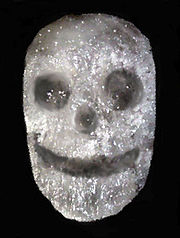http://groups.google.com/group/alt.gossip.celebrities/browse_thread/thread/2aea1fb054cd3c0f/9f2810671ae188f8?hl=en&lnk=st&q=damien+hirst
The 1999 Sensation Exhibit mentioned in the above article
http://en.wikipedia.org/wiki/Sensation_exhibition
Hirst on wikipedia
http://en.wikipedia.org/wiki/Damien_Hirst
Hirst on art:
Hirst sees the real creative act as being the conception, not the execution, and that, as the progenitor of the idea, he is therefore the artist:
| “ | Art goes on in your head," he says. "If you said something interesting, that might be a title for a work of art and I'd write it down. Art comes from everywhere. It's your response to your surroundings. There are on-going ideas I've been working out for years, like how to make a rainbow in a gallery. I've always got a massive list of titles, of ideas for shows, and of works without titles. |
on Appropriation:
ppropriation
In 2000, Hirst was sued for breach of copyright over his sculpture, Hymn, which was a 20 foot, six ton, enlargement of his son Connor's 14" Young Scientist Anatomy Set, designed by Norman Emms, 10,000 of which are sold a year by Hull-based toy manufacturer Humbrol for £14.99 each. Hirst paid an undisclosed sum to two charities, Children Nationwide and the Toy Trust in an out-of-court settlement. The charitable donation was less than Emms had hoped for.[9]
In 2006, a graphic artist, Robert Dixon, stated Hirst's print Valium had "unmistakable similarities" to one of his own designs. Hirst's manager contested this by explaining the origin of Hirst's piece was from a book The Penguin Dictionary of Curious and Interesting Geometry (1991)—not realising this was where Dixon's design had been published.[25]
In 2007, artist John LeKay said he was a friend of Damien Hirst 1992–1994 and had given him a "marked-up duplicate copy" of a Carolina Biological Supply Company catalogue, adding "You have no idea how much he got from this catalogue. The Cow Divided is on page 647 – it is a model of a cow divided down the centre, like his piece." This refers to Hirst’s work Mother and Child, Divided—a cow and calf cut in half and placed in formaldehyde.[25] LeKay also claimed Hirst had copied the idea of For the Love of God from LeKay's crystal skulls made in 1993, and said, "I would like Damien to acknowledge that 'John really did inspire the skull and influenced my work a lot.'"[25]
those who applaud him:
"There is no comparison between him and me; he developed a whole new way of making art and he's clearly in a league of his own. It would be like making comparisons with Warhol."[27] Despite Hirst's insults to him, Saatchi remains a staunch supporter, labelling Hirst a genius[26] and stating:
| “ | General art books dated 2105 will be as brutal about editing the late 20th century as they are about almost all other centuries. Every artist other than Jackson Pollock, Andy Warhol, Donald Judd and Damien Hirst will be a footnote.[28] | ” |
****I would quickly to take note that Saatchi left out Duchamp. Also, in my readings I have not come across Pollock as frequently as perhaps the general public would like****
Hirst's restaurant and pharmacy:Hirst's best known restaurant involvement was Pharmacy, located in Notting Hill, London, which closed in September 2003. Although one of the owners, Hirst had only leased his art work to the restaurant, so he was able to retrieve and sell it at a Sotheby's auction, earning over £11 million. Some of the work had been adapted, e.g. by signing it prior to the auction.[34].
Hirst opened and currently helps to run a seafood restaurant, 11 The Quay, in the seaside town of Ilfracombe in the UK.
Those who aren't fond of Hirst:The Stuckist art group was founded in 1999 with a specific anti-Britart agenda by Charles Thomson and Billy Childish;[31] Hirst is one of their main targets. They wrote (referring to a Channel 4 programme on Hirst):
| “ | The fact that Hirst's work does mirror society is not its strength but its weakness - and the reason it is guaranteed to decline artistically (and financially) as current social modes become outmoded. What Hirst has insightfully observed of his spin-paintings in Life and Death and Damien Hirst is the only comment that needs to be made of his entire oeuvre: "They're bright and they're zany - but there's fuck all there at the end of the day."[30] |
I just wanted to post these little tid bits to get me thinking, to make me feel obliged to respond to them.
